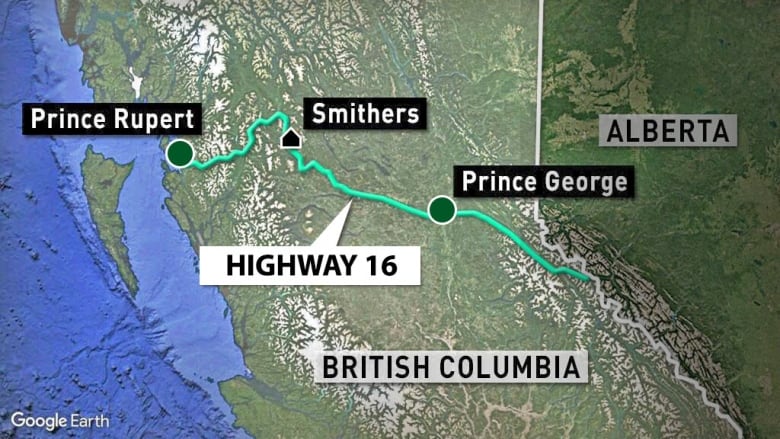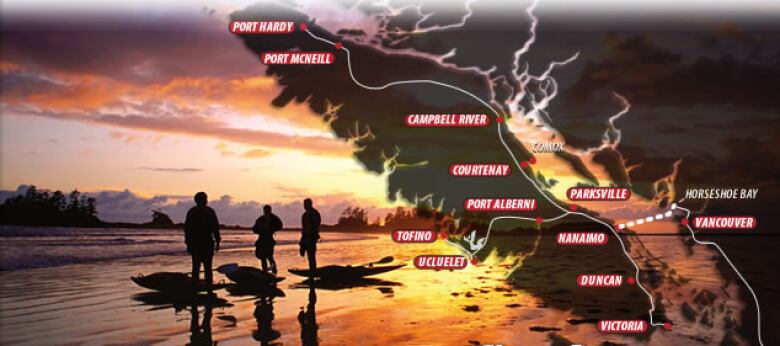Greyhound is leaving northern British Columbia: Here's what you need to know
The company will cease nearly all operations in the region on June 1, 2018

B.C.'s Passenger Transportation Board hasallowed Greyhound Canada to cease operating seven routes throughout the province, including all runs connecting communities in northern B.C. In a region known for unsolved disappearancesalong the Highway of Tears,the departure has attracted widespread criticism from those who say the lack of bus service will putvulnerable communities at risk.
Here's what you need to know about the decision.
Which routes are being cut?
Greyhound is eliminating seven routes, moslyin northern B.C. They are:
- Prince Rupert to Prince George (via Fort St. James)
- Prince George to Valemount
- Prince George to Dawson Creek
- Dawson Creek to Whitehorse (via Fort Nelson)
- Victoria to Nanaimo
- Victoria to Vancouver
- University Endowment Lands (UBC) Vancouver to Whistler
The company will continue to offer service from Dawson Creek and Valemountto Edmonton, as well as from Prince George south to Kamloops and Vancouver.
Why is Greyhound leaving northern B.C.?
The company says is has been bleeding money in the province, losing roughly $35,000 a day for atotal of about $70 million dollars over the past six years.
Greyhound says the rise of ride-sharing services and new B.C. Transit routes along Highway 16 make itimpossible to turn a profit,and any future solution willrequire public subsidy.
Cananything be done to make Greyhound stay?
In its ruling, the B.C. Transportation Board said it "cannot compel a private business to sustain significant financial losses indefinitely."
Board chair Catharine Read said her members talked to Greyhound about continuing to serve northern B.C. with either fewer runs or smaller buses, and determined neither was a viable option.

She also said theyheard from members of the public who thought Greyhound should no longer be allowed to operate in the province if it didn'tserve the north, but said that would likely leave even more people without bus service.
"We haven't seen any applications from any company or group of individuals who have been keen on taking on the whole of the province," she said.
B.C. Transportation Minister Claire Trevena called the ruling "unfortunate" but said she recognizes the independent nature of the board.
What is the PassengerTransportation Board, anyway?
It's an independent tribunal consisting offivepart-time members appointed by provincial cabinet.
Formed in 2004 as part of the province's Passenger Transportation Act, they are responsible for decisions surrounding taxi, limousine, shuttle van and inter-city bus services in British Columbia. For example, if a new taxi company wants to set up shop in anywhereB.C., it mustapply to to the Board.
Doesn't northern B.C. have public transit between communities now?
In 2017, B.C. Transit began offering short inter-community runs along some parts of Highway 16 west of Prince George, an area known as the Highway of Tears for the number of women, mostly Indigenous, to go missing or be murdered along it.
Though popular approximately 5,000 people have used the service it doesn't fulfilthe same role as Greyhound. For example, while a passenger could get a direct ride from Prince George to Prince Rupert on Greyhound, no such option exists using the B.C. Transit Service.

Even traveling from Prince George to Smithers, less than 400 kilometers away, would be a two-day trip using the B.C. Transit, with an overnight stay in Burns Lake.
The service doesn't extend to Prince Rupert, nor does it serve any part of northeast B.C., from Prince George to Dawson Creek and on to Whitehorse.
What other options are there?
Northern Healthoffers a connections busfor patients who have to travel for medical services. Although companions are allowed to use the service, they can be bumped in favour of other patients, and trips are limited.
Via Rail offers passenger service from Prince Rupert east to Jasper, but the service is often stalled while waiting for cargo trains. It also doesn't extend into northeast B.C.
Prince George has an international airport, and several other communities have regional flights, but the costcan be prohibitive.
When will Greyhound stop operating in the north?
Greyhound must continue operating in northern B.C. until the end of May in order to ensure there are transit options available throughwinter.
Will anyone take Greyhound's place?
Read said the Passenger Transportation Boardhasnot received any applications to replace Greyhound in the north. However, the board saidthat by making Greyhound stay in the region until May 31, it would provide an opportunity for other interested companies to apply to start their own routes.
Dylan Green, who owns Tofino Bus All Island Express, said he believes more customer-focused companies might be able to serve the north.

Green said he was able to capitalize on the demand for inter-city bus service on Vancouver Island after Greyhound cancelled most of its routes there in 2013.
He said it would be wise for prospective Greyhound replacements to work with tourism operators such as ski hills to design schedules.
"Use your local knowledge," he said. "It will be interesting to see if someone steps up."
What about freight?
Greyhound said it has no plans to stop offering delivery services in northern B.C. In fact, without the need to offer rides to customers, the company said it will able to be even more flexible in its options.
The Passenger Transportation Board has no jurisdiction over delivery services.
What happens now?
Trevena said providing safe transit for northern B.C. communities is a top priority. She will be meeting with Indigenous and municipal leaders incoming days to discuss how to make that happen, but wouldn't say what the province is willing to offer in terms of funding.
Although some Yukon residents have called on their government to subsidize bus routes into British Columbia, a spokesperson for the territory said Greyhound is not an essential service andthe government is not consideringa subsidized bus service in the region.
With files from Audrey McKinnon and Sarah Towle












_(720p).jpg)


 OFFICIAL HD MUSIC VIDEO.jpg)
.jpg)



























































































